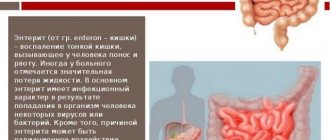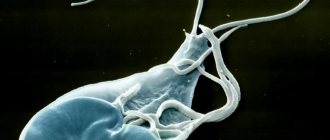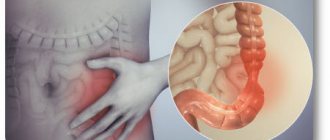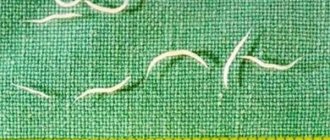Diseases of the small intestine can be diagnosed in people of any age. In young children, pathologies develop because the digestive system has not yet matured, and in adults, the main factor is poor nutrition, insufficient physical activity, and stress.
Deterioration of intestinal function leads to changes in the activity of other body systems. That is why it is recommended to consult a gastroenterologist at the first signs of digestive dysfunction.
Structure
The small intestine is a very long (2 to 5 m) hollow tube. It starts from the stomach and ends in the ileocecal angle, at the point of its connection with the cecum. Anatomically, the small intestine is conventionally divided into three sections:
1. Duodenum. It is located in the back of the abdominal cavity and is shaped like the letter “C”;
2. Jejunum. Located in the middle part of the abdominal cavity. Its loops lie very freely, covered with peritoneum on all sides. This intestine got its name because when autopsying corpses, pathologists almost always find it empty;
3. Ileum - located in the lower part of the abdominal cavity. It differs from other parts of the small intestine in having thicker walls, better blood supply and a larger diameter.
Treatment of acute form
Therapeutic measures can now be discussed. What kind of treatment is indicated for the patient is determined by the doctor. Because drugs that can eliminate, for example, catarrhal inflammation of the small intestine with an allergic component, will be completely powerless in the fight against the disease that has arisen due to dysbiosis.
It is very important to act directly on the cause. Be that as it may, the acute form is treated in a hospital. Usually patients are admitted to the gastroenterology department, but if the illness is viral in nature, then the person is sent to the infectious diseases department.
Each patient is prescribed bed rest, plenty of fluids, dietary nutrition, restorative and symptomatic treatment.
If severe dysbiosis develops, then the intestinal flora is corrected. And diarrhea is eliminated with astringents. If protein metabolism is disrupted, then polypeptide solutions are administered.
As a rule, treatment does not take more than one week. When acute symptoms subside, the person is discharged.
How to restore bowel function: folk recipes
Restoration is effective using oats and yogurt. It is necessary to boil oats: 3 tbsp. l. The grains are poured with water 1:2, heated for half an hour in a water bath and drained. A decoction of 30 ml is taken three times a day, half an hour before meals. Flax seeds and bran, which work as a natural sorbent, will help enhance the cleansing effect of oat decoction.
2 weeks after cleansing the mucous membrane with oat decoction, you can move on to the next stage: colonizing the intestines with beneficial microflora. Homemade fermented milk products will help with this: yogurt, kefir. Pharmaceutical probiotics are also effective. The final stage is proper nutrition, a healthy and rational lifestyle, and the elimination of bad habits.
Digestion in the small intestine
The food mass passes through the small intestine in about four hours. During this time, the nutrients contained in the food continue to be broken down by enzymes in the intestinal juice into smaller components. Digestion in the small intestine also involves active absorption of nutrients. Inside its cavity, the mucous membrane forms numerous outgrowths and villi, which significantly increases the absorption surface area. So in adults, the area of the small intestine is at least 16.5 square meters.
Healthy lifestyle and diet features
If you have inflammation of the intestinal mucosa, it is necessary to maintain a healthy lifestyle and constantly add prebiotics to your daily diet. They are found in the following foods: onions, bananas, garlic, whole wheat, tomatoes, asparagus, leeks, artichokes, chicory.
It is also recommended to drink lacto- and bifidobacteria. They effectively restore the microflora of the stomach and intestines. Over time, the mucous membrane also returns to normal. Reception must be maintained for at least a month, otherwise the desired therapeutic effect will not follow. During treatment, the patient should avoid drinking alcohol.
Try to consume fermented milk products that are useful for this diagnosis as much as possible; sour cream and kefir are especially effective. They tend to have a beneficial effect on the human intestines, perfectly cleanse it, and also normalize the digestion process.
The course of treatment should be at least 1-2 months, since if it is stopped earlier, the disease may reappear.
Take care of your health and nutrition, which should be of high quality and regular. You need to eat natural foods every day - vegetables, fruits, vegetables and cereals. They should be consumed whole according to the seasons of the year - cereals in the shell, fruits, berries, seeds, roots, leaves.
Natural products contain minerals, enzymes, vitamins, structured water and everything necessary for normal absorption of food. The removal of harmful substances is facilitated by the abundance of fiber and regulators of intestinal motility.
Based on experience, we have established that the large intestine can under no circumstances develop and function normally if a person eats mainly only boiled or thermally processed food. Therefore, it is almost impossible to find a person whose colon is perfectly healthy. If you feel unwell, your first step should be a series of colonic lavages or enemas. After this, fresh vegetable juices will more effectively carry out the process of its restoration. It has been established that the best nutrition is a mixture of carrot and spinach juices. This mixture nourishes the nerves and muscles of the colon and small intestine.
In view of the fact that cleansing with the help of an enema has been repeatedly discussed before, let’s look at how you can cleanse and improve the health of the entire gastrointestinal tract, and not just the large intestine, with the help of nutrition.
The process of cleansing the large intestine with the help of nutrition is quite long and painstaking. Don’t be under the illusion of thinking that you ate fresh carrot and cabbage salad a couple of times without seasonings or oil and that’s enough. No. You need to radically reconsider and change your diet, making it ordinary and regular.
Your nutrition should be natural and whole. This means that you should consume natural foods (fruits, vegetables, cereals) in their whole form every day (coated cereals, berries, fruits, seeds, leaves, roots - all according to the seasons). Natural foods provide a natural flow of substances through the body. They contain everything for normal absorption (minerals, vitamins, enzymes, structured water, etc.) and excretion (abundance of fiber, various regulators of intestinal motility, etc.). It is imperative to switch to such a diet. Anything else will inevitably lead to abnormal consequences.
Functions of the small intestine
Like any other organ in the human body, the small intestine performs not one, but several functions. Let's look at them in more detail:
- The secretory function of the small intestine is the production by the cells of its mucous membrane of intestinal juice, which contains enzymes such as alkaline phosphatase, disaccharidase, lipase, cathepsins, peptidase. All of them decompose the nutrients contained in chyme into simpler ones (proteins into amino acids, fats into water and fatty acids, and carbohydrates into monosaccharides). An adult secretes approximately two liters of intestinal juice per day. It contains a large amount of mucus, which protects the walls of the small intestine from self-digestion;
- Digestive function. Digestion in the small intestine involves the breakdown of nutrients and their further absorption. Thanks to this, only indigestible and indigestible foods enter the colon.
- Endocrine function. In the walls of the small intestine there are special cells that produce peptide hormones, which not only regulate intestinal function, but also affect other internal organs of the human body. Most of these cells are located in the duodenum;
- Motor function. Due to the longitudinal and circular muscles, wave-like contractions of the walls of the small intestine occur, pushing the chyme forward.
What are the symptoms of gastrointestinal problems?
The gastrointestinal tract includes many organs, with each individual organ performing its own specific task. The upper gastrointestinal tract includes the oral cavity, pharynx, esophagus and other adjacent organs. The middle section is the stomach, liver and pancreas. The lower section includes the intestines (small, large and rectum).
Disturbances in different parts of the gastrointestinal tract can manifest themselves in different ways:
- Upper section (esophagus, stomach) – heartburn, bitterness in the mouth, acid belching, problems swallowing, nausea, pain and burning in the upper abdomen3.
- Middle and lower sections (small and large intestines) – pain and cramping in the abdomen, stool disturbances, flatulence: gas formation, bloating and rumbling3.
There is a misconception that diarrhea is associated with problems in the stomach, but this symptom indicates problems specifically in the intestines.
With constipation, pain may appear that does not go away until the intestines are cleansed. In addition, constipation may be accompanied by unpleasant gastric symptoms characteristic of the upper gastrointestinal tract: dry mouth, nausea, loss of appetite3. Such symptoms may disappear after visiting the toilet.
Diarrhea or diarrhea occurs spontaneously, during or before eating or even without eating. Most often, the activator of an unpleasant state is an emotional shock of any nature. This manifestation is popularly called “bear disease.”
It is worth noting that any symptoms may appear on their own or be part of an overall problem. If such symptoms bother you regularly and are accompanied by pain, then most likely irritable bowel disease may be behind them - the disorder is not serious, but requires treatment. And it must be treated wisely.
Lymphatic vessels
The lymphatic vessels of the small intestine begin in the villi of the mucous membrane; upon leaving the wall of the small intestine they enter the mesentery. In the mesenteric area, they form transport vessels that are capable of contracting and pumping lymph. The vessels contain a white liquid similar to milk. That's why they are called milky. At the root of the mesentery are the central lymph nodes.
Some lymphatic vessels may empty into the thoracic stream, bypassing the lymph nodes. This explains the possibility of rapid spread of toxins and microbes through the lymphatic route.
Diseases of the small intestine
All diseases of the small intestine have similar symptoms and are manifested by abdominal pain, flatulence, rumbling, and diarrhea. Stool occurs several times a day, profusely, with the remains of undigested food and a large amount of mucus. Blood in it is observed extremely rarely.
Among diseases of the small intestine, inflammation is most often observed - enteritis, which can be acute or chronic. Acute enteritis is usually caused by pathogenic microflora and, with full treatment, ends with complete recovery within a few days. With long-term chronic enteritis with frequent exacerbations, patients also develop extraintestinal symptoms of the disease due to impaired absorption function of the small intestine. They complain of weight loss and general weakness, and they often develop anemia. A deficiency of B vitamins and folic acid leads to cracks in the corners of the mouth (jams), stomatitis, and glossitis. Insufficient intake of vitamin A in the body causes dry corneas and impaired twilight vision. Impaired calcium absorption can cause the development of osteoporosis and the resulting pathological fractures.
Therapy for chronic form
Its specifics should also be discussed within the framework of the topic concerning the symptoms and treatment of inflammation of the small intestine. In this case, the person is also placed in a hospital for therapy.
Doctors prescribe diet No. 4, which involves avoiding rough, sour, spicy foods, as well as anything that can harm the mucous membrane. It is important that the diet is enriched with carbohydrates, proteins and fats. Avoid milk and fiber-rich foods.
During periods of remission, a balanced diet is indicated, which contains enough minerals, vitamins and valuable elements.
Diagnostics
To diagnose the development of diseases of the small intestine, specialists resort to the following research methods:
- capsule examination;
- Ultrasound;
- colonoscopy;
- endoscopy;
- fiberoscopy;
- radiography.
As for analyses, standard procedures are provided here. The patient provides a stool sample and blood is drawn. The stool is examined for the presence of helminths. When studying blood, the speed of movement of red blood cells is taken into account. Additionally, diagnostics are performed, which allows one to evaluate the functioning of the liver and thyroid gland.
Small bowel rupture
Among all the organs of the abdominal cavity, the small intestine is most susceptible to traumatic injury. This is due to the insecurity and significant length of this section of the intestine. An isolated rupture of the small intestine is observed in no more than 20% of cases, and more often it is combined with other traumatic injuries of the abdominal organs.
The most common mechanism of traumatic injury to the small intestine is a direct and fairly strong blow to the abdomen, leading to compression of the intestinal loops against the pelvic bones or spine and damage to their walls.
When the small intestine ruptures, more than half of the victims experience shock and significant internal bleeding.
The only treatment for small bowel rupture is emergency surgery. During surgery, bleeding is stopped (hemostasis), the source of intestinal contents entering the abdominal cavity is eliminated, normal intestinal patency is restored and the abdominal cavity is thoroughly sanitized.
The sooner the operation is performed from the moment of injury to the small intestine, the greater the chance of recovery for the victim.
Why is enteritis dangerous?
Gastroenterologists classify this disease as extremely dangerous to the life and health of the patient. If you delay going to the clinic, thereby delaying the start of treatment, the consequences may be irreversible.
Thus, the development of enteritis can lead to:
- to internal intestinal bleeding leading to death;
- to necrosis, when the intestinal tissue begins to die.
Ignoring the inflammatory process in this part of the intestine leads to the development of a chronic stage, when the glands cannot perform their functions, and the digestive process will be seriously impaired.
How to properly restore the gastric mucosa
- How to start treatment
- Drug treatment
- Medicines
- Restoration of the mucosa during treatment with antibiotics
- Treatment methods, auxiliary diets
The health of the human body depends on nutrition. An unhealthy stomach causes many diseases. How to restore the gastric mucosa?
This question is asked very often when pain appears in the stomach area and discomfort is felt. The process of restoring the gastric mucosa is quite complex, sometimes lasting a very long time. Treatment should be started as early as possible so that the disease does not become critical.
How to start treatment
First of all, you need to forget about cigarettes and stop drinking alcohol. The renunciation of such bad habits must be complete, without any exceptions. These habits equally affect digestion; they are terrible enemies of the gastric mucosa.
You definitely need to work out your own menu to restore the gastric mucosa. Eating should be frequent, but in limited quantities. Coffee should be drunk only before meals, this should not be done after it. Spicy, fried and fatty foods are excluded from the diet.
Poorly digested in the body:
Food does not need to be taken very hot; slightly warmed dishes are considered the best option.
In order for the gastric mucosa to be restored, medications are used to help eliminate those elements that create conditions for the development of gastritis and its exacerbation. Medicines help restore the mucous membrane and start restorative processes.
When treatment is carried out, the patient eats strictly according to his schedule. A diet is prescribed, usually only plant-based. It is agreed upon with a doctor, who, depending on the type of gastritis and the amount of acidity, prescribes its form.
Return to contents
Prevention
To prevent inflammation of the small intestine, you need to follow these recommendations:
- Eat right, enrich your diet with healthy foods.
- Handle food carefully. Do not consume possible toxic products.
- Follow hygiene recommendations.
- Take medications with caution, and only when indicated.
But the most important thing is the timely detection and subsequent treatment of gastrointestinal diseases, endocrine and metabolic disorders.
And at the first suspicious symptoms, you should immediately go to the doctor, without taking any antispasmodics or analgesics, as they “blur” the symptomatic picture, and this significantly complicates the diagnosis.










